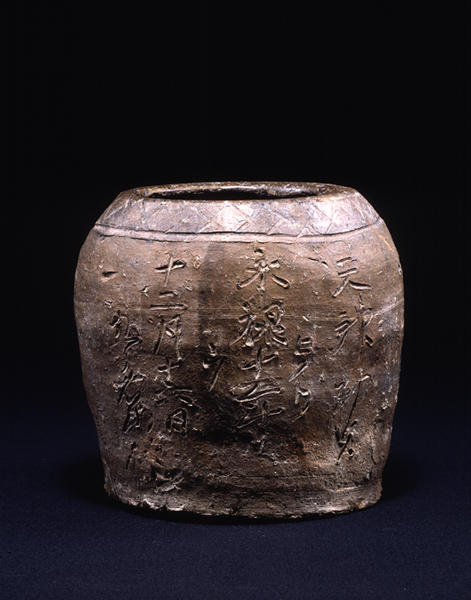信楽桧垣文壺(水指)
- 滋賀県・信楽窯
- 安土桃山時代
- 16c
- H-16.3 D-17
口頸部を大きく欠く檜垣文の壼である。元々この形であったかどうか定かではないが、今では水指となっている。肩部には檜垣文が刻まれているが、この作品で注目したいのは、胴部に記された刻文である。そこには「天神勅旨 永禄十年十二月十六日 九郎右エ門作」とある。現在でも信楽町勅旨には天神神社が存在し、その近くには古い窯跡があることから、本品は天神神社に奉納されたものであると考えられなくはない。いずれにしろそれ以上は想像の域を出ないが、刻文の記された貴重な作例といえよう。
Catalogue Entry
Azuchimomoyama Period, dated by inscription to Eiroku 10 (1567)
H. 16.3, MD. 12.5, TD. 17.3, BD. 15.0
Miho Museum, Shiga
This inscribed jar has lost all of its mouth and neck area. While the original shape of the jar is not apparent, today it is used as a mizusashi fresh water jar for the tea ceremony. The clay has very few feldspar and silica inclusions and the form was created through coil building. Lightly fired, the surface of the pot is dark brownish in color. The shoulders are inscribed with the so-called multiple Xs known as the cypress fence pattern but it is the text inscribed on the torso of the work which is most noteworthy. This gives the place, date and name of its maker, stating "Tenjin chokushi Eiroku ju^nen (hinoto u) ju^nigatsu ju^roku nichi, Kuro^emon saku." A Tenjin Shrine still exists in Chokushi, Shigaraki cho^, and there are old kiln remains in that area. This would lead us to believe that this pot was made for dedication to the Tenjin Shrine. In any event, these suppositions must remain pure speculation, while the work remains an important example of a pot with an inscribed text.
